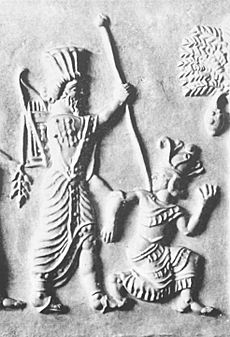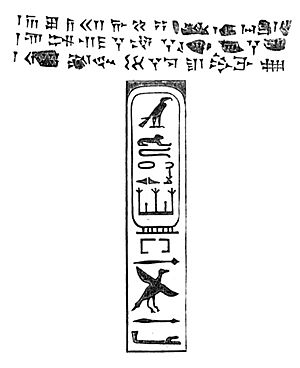Artaxerxes I facts for kids
Quick facts for kids Artaxerxes I𐎠𐎼𐎫𐎧𐏁𐏂 |
|
|---|---|
|
|
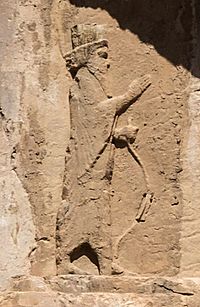
Relief of Artaxerxes I, from his tomb in Naqsh-e Rustam
|
|
| King of Kings of the Achaemenid Empire | |
| Reign | 465–424 BC |
| Predecessor | Xerxes I |
| Successor | Xerxes II |
| Born | Unknown |
| Died | 424 BC, Susa |
| Burial | Naqsh-e Rustam, Persepolis |
| Spouse | Queen Damaspia Alogyne of Babylon Cosmartidene of Babylon Andia of Babylon |
| Issue | Xerxes II Sogdianus Darius II Arsites Parysatis |
| House | Achaemenid |
| Father | Xerxes I |
| Mother | Amestris |
| Religion | Zoroastrianism |
Artaxerxes I was a powerful king of the ancient Persian Empire. He ruled as the fifth "King of Kings" from 465 to 424 BC. He was the third son of Xerxes I, another famous Persian ruler.
In ancient Greek writings, Artaxerxes was sometimes called "Longimanus." This means "long-handed." People said his right hand was longer than his left.
Challenges in Egypt
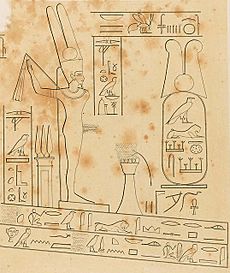
Artaxerxes faced a big problem in Egypt early in his rule. A prince named Inaros II led a revolt against Persian control. This happened between 460 and 454 BC.
Inaros got help from the Athenians, who were rivals of Persia. They even defeated a Persian army. But after a long fight, the Persian army, led by Megabyzus, finally won. Inaros was captured and taken to the Persian capital, Susa.
Dealing with Greece
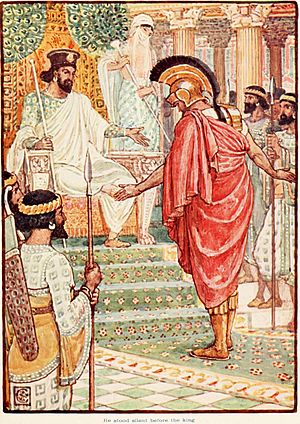
After a major battle called the Battle of the Eurymedon (around 469 BC), the fighting between Greece and Persia had stopped for a while. When Artaxerxes I became king, he tried a new plan. He decided to weaken the Athenians by giving money to their enemies in Greece.
This strategy led to more fighting in 450 BC. The Greeks attacked at the Battle of Cyprus. After this, the fighting stopped again. Some historical sources say that a peace treaty, called the Peace of Callias, was made in 449 BC. However, historians still debate if this treaty truly existed.
Artaxerxes I also offered a safe place to Themistocles. Themistocles was a famous Athenian general who had defeated Artaxerxes' father, Xerxes, at the Battle of Salamis. Themistocles had been forced to leave Athens. Artaxerxes gave him land and supplies to live comfortably. Themistocles then learned Persian customs and language.
Artaxerxes in the Bible
King Artaxerxes is mentioned in the Bible, in the books of Ezra and Nehemiah. He is shown as a king who helped the Jewish people.
In the book of Ezra, Artaxerxes gave permission to Ezra, a Jewish priest and scribe, to go to Jerusalem. Ezra was to help organize the religious and civil life of the Jewish community there. Ezra left Babylon in the seventh year of Artaxerxes' rule and arrived in Jerusalem.
Later, in Artaxerxes' twentieth year, Nehemiah was the king's cup-bearer. Nehemiah was sad because the city of Jerusalem was still undefended. Artaxerxes noticed Nehemiah's sadness and asked about it. The king then sent Nehemiah to Jerusalem. He gave Nehemiah letters to ensure his safe travel and to get materials to rebuild the city walls and the temple.
The rebuilding of the Jewish community in Jerusalem had started earlier, under Cyrus the Great. He allowed Jewish people who were held captive in Babylon to return home. The foundation of the "Second Temple" was laid in 536 BC. The temple was finally finished in 516 BC, during the reign of King Darius.
His Children
Artaxerxes I had many children. Some of his most well-known children include:
- By Queen Damaspia:
- Xerxes II
- By Alogyne of Babylon:
- Sogdianus
- By Cosmartidene of Babylon:
- Darius II
- Arsites
- By Andia of Babylon:
- Bogapaeus
- Parysatis, who became the wife of Darius II Ochus
He also had other children by various wives.
See also
 In Spanish: Artajerjes I para niños
In Spanish: Artajerjes I para niños
- Artoxares
- Ezra–Nehemiah
- List of biblical figures identified in extra-biblical sources


